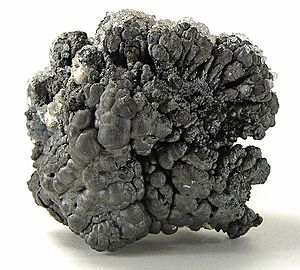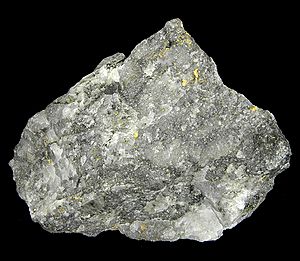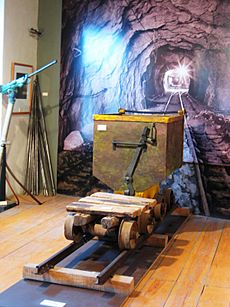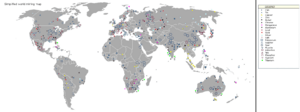Ore facts for kids


An ore is a special kind of mineral or rock that contains valuable metals. These metals are often very useful or expensive. Ores are usually found deep underground and are brought to the surface by mining. Sometimes, they can even be found right on the Earth's surface. Once the ore is out of the ground, people use different methods to get the pure metal out of it. For example, iron ore is heated in a special oven called a blast furnace to separate the iron.
Contents
What are Ore Deposits?
An ore deposit is a place where a large amount of ore has gathered. Think of it as a natural treasure chest filled with valuable minerals. Geologists, who study rocks and the Earth, give these deposits names. Sometimes they are named after the place they were found, like Witwatersrand in South Africa. Other times, they are named after the person who discovered them, or even after a fun or mythical name!
How Do We Get Ore?
Getting ore out of the ground is a big job that involves many steps. It's like a long project with different stages, from finding the ore to cleaning up the land afterward.
The main steps for getting ore are:
- Finding the ore: This is called exploration. Scientists look for places where ore might be hidden and then figure out how much is there.
- Figuring out how much ore there is: Experts use math to estimate the size and quality of the ore deposit. This helps them know if it's worth digging.
- Checking if it's worth digging: Before spending a lot of money, they do a "pre-feasibility study." This is a quick check to see if the project makes sense financially.
- Planning the whole mine carefully: If the first check looks good, they do a detailed "feasibility study." This plan covers everything: how to dig, how to get the metal out, how much it will cost, and how to clean up the area when the mining is done.
- Building the mine: This involves creating ways to reach the ore deep underground and setting up all the necessary machines and buildings.
- Running the mine: This is when the actual mining happens, and the ore is dug out and processed.
- Cleaning up afterwards: Once mining is finished, the land is restored. This is called reclamation, and it makes the land safe and useful again for other purposes.
Trading Ores Around the World
Ores and the metals they contain are traded all over the world. This is a huge part of international trade. Why? Because ores aren't found everywhere. Some countries have a lot of a certain ore, while others need it for their factories.
Big metals like copper, lead, zinc, and nickel are often traded on special markets, like the London Metal Exchange. This helps set fair prices for these important materials. Iron ore is usually traded directly between the companies that mine it and the companies that use it.
Some less common metals, like lithium or rare earth elements, don't have big international markets. Their prices are often agreed upon directly between the buyer and seller. The World Bank reported that in 2005, China was the biggest buyer of ores and metals, followed by the United States and Japan.
Important Ore Minerals
Many different minerals are considered ores because they contain valuable metals. Here are some examples:
- Bauxite: This ore is used to make aluminium, which is a light and strong metal used in cans and airplanes.
- Cassiterite: This mineral is the main source of tin.
- Chalcopyrite: A common ore for getting copper.
- Chromite: Used to produce chromium, which makes stainless steel shiny and strong.
- Cinnabar: This is the main ore for mercury, a unique liquid metal.
- Galena: The most important ore for lead.
- Hematite and Magnetite: These are key ores for making iron, which is used to create steel for buildings and cars.
- Native gold: Sometimes, gold is found in its pure form, often mixed with quartz or in riverbeds.
- Pyrolusite: An important ore for manganese.
- Sphalerite: The main ore for zinc.
- Uraninite: Also known as pitchblende, this ore contains uranium, used in nuclear energy.
Images for kids
-
Iron ore (Banded iron formation, Minnesota) consisting of magnetite (silver-grey bands) and quartz (light and red bands). The red bands also contain hematite.
See also
 In Spanish: Mena (minería) para niños
In Spanish: Mena (minería) para niños







